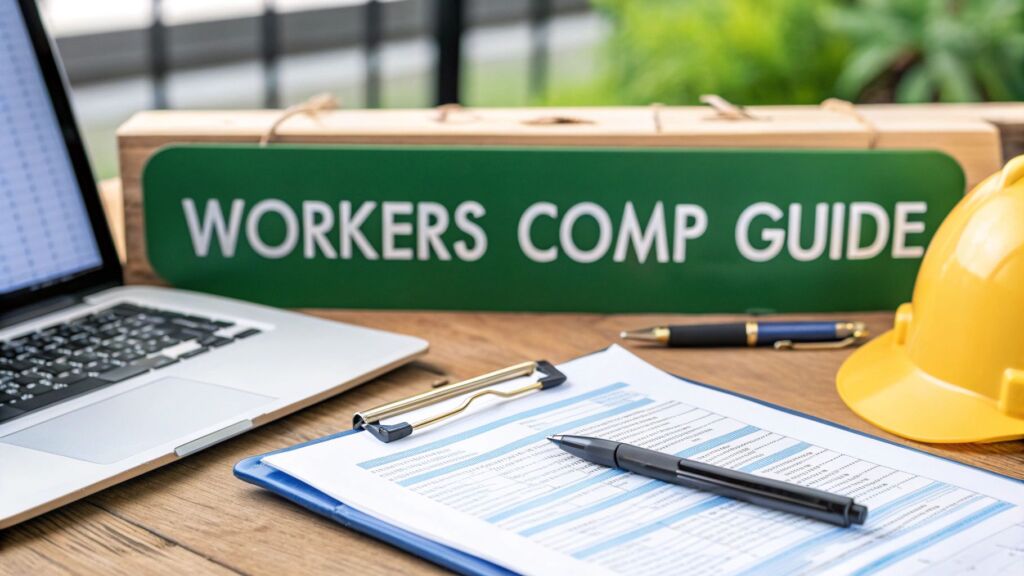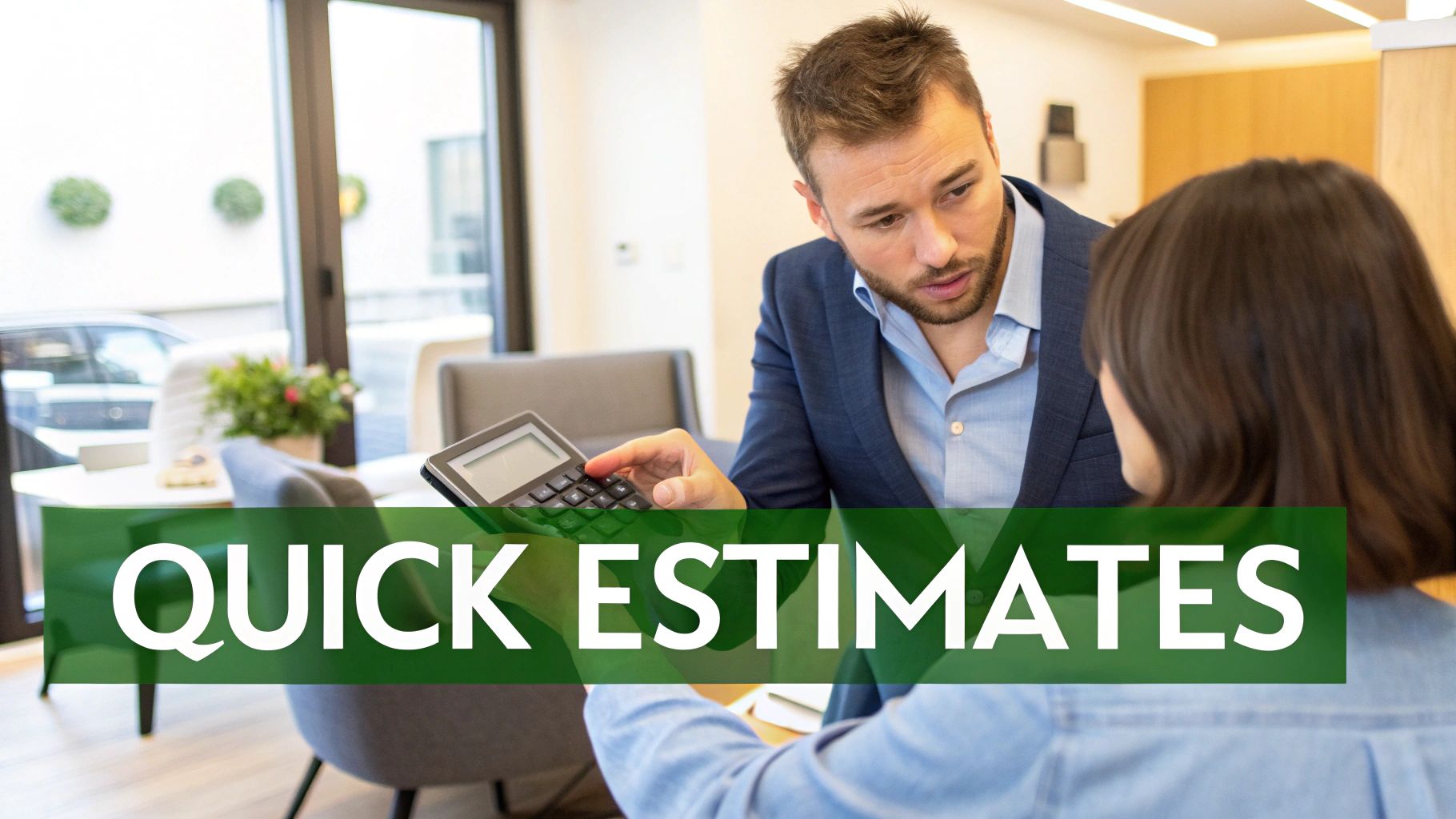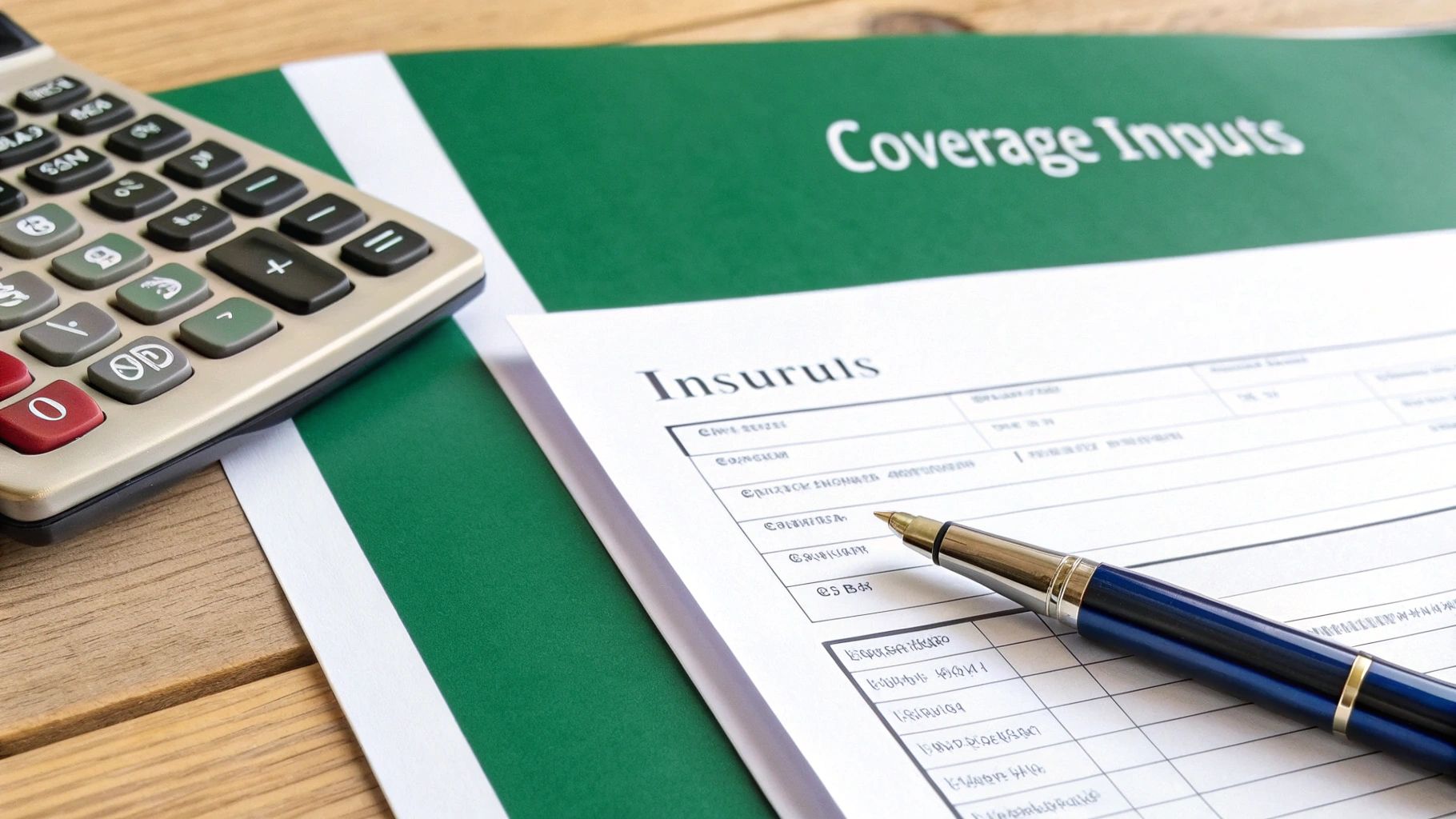Think of a commercial property insurance calculator as your first real look into what your premiums might be. These online tools aren't just guessing; they crunch data from thousands of businesses to give you a solid baseline estimate for your own. It's really the fastest way to get a handle on potential costs without committing to a full-blown quote process just yet.
How to Use a Commercial Property Insurance Calculator
Alright, let's walk through how to actually use one of these calculators. The whole point is to move from a vague idea of "how much will this cost?" to a concrete number you can use for budgeting and planning. It’s more than just a math problem; using the tool correctly gives you a peek behind the curtain at what really drives your insurance rates.
We'll break down exactly what information you need to have on hand and, more importantly, why it matters. This way, you’re not just plugging in numbers—you’re learning what makes your business more or less risky in an insurer’s eyes.
Understanding the Data Behind the Estimate
So, what’s the magic behind these calculators? It’s data. Lots of it. Modern tools are incredibly sophisticated, comparing your business profile against a massive database of similar companies in your area. They look at what others with your revenue, in your industry, and in your zip code are paying, and then they model the risks you're likely to face.
This data-driven approach is why the estimates can be surprisingly accurate for a first look. Of course, premiums swing wildly depending on the business. I’ve seen some low-risk ventures get coverage for as little as $17 per month, but that's not the norm for everyone. In fact, one popular online platform reports that about 56% of its customers pay less than $25 monthly for just a basic Business Owner's Policy, which shows how specific the pricing can get. If you want to dive deeper into how this works, NextInsurance.com has some great insights on data-driven insurance quoting.
Key Takeaway: Remember, a calculator provides a ballpark estimate, not a final, bindable quote. Think of it as an educational tool that arms you with the knowledge to have a much more productive conversation with an insurance agent later on.
To get a truly useful estimate, you need to come prepared. The old saying "garbage in, garbage out" is especially true here. The more accurate your information, the more reliable your estimate will be.
Before you start, it's a good idea to gather a few key pieces of information. The table below outlines what you'll typically need to provide.
Key Inputs for an Accurate Insurance Calculation
| Input Category | What It Means | Why It Matters for Your Premium |
|---|---|---|
| Business Location | Your complete street address. | Insurers use this to assess local risks like weather patterns (hurricanes, floods), crime rates, and fire department proximity. |
| Industry & Operations | What your business actually does day-to-day. | A quiet office has far different property risks than a bustling restaurant with deep fryers or a warehouse storing flammable goods. |
| Property Value | The total replacement cost of your building and everything inside it. | This is the core of your coverage. It includes equipment, inventory, furniture, and computers. The higher the value, the higher the premium. |
| Building Details | Age, construction materials, and the condition of major systems. | A new, fire-resistant brick building will cost less to insure than an older wood-frame structure with outdated electrical wiring. |
Having these details ready will make the process smooth and, most importantly, will give you an estimate you can actually trust as you move forward.
Gathering Your Essential Property Details
To get a truly useful estimate from a commercial property insurance calculator, you need to start with solid, accurate data. The old saying "garbage in, garbage out" has never been more true. The more precise the details you provide, the more reliable your resulting quote will be. It’s all about giving the calculator the information it needs to paint an accurate picture of your specific risk profile.
The first number most people think of is their property's value, but there's a crucial detail here. You must use the replacement cost, not the market value. It's a common mix-up. Market value is what your property, including the land, would sell for today. Replacement cost is what it would actually cost to rebuild your building from scratch using similar materials—and that's what the insurance policy is designed to cover.
Documenting Key Building Characteristics
Beyond the big-picture value, the nitty-gritty details of your building's construction are huge factors. From an insurer's perspective, a modern, fire-resistant brick building is a world away from an older, wood-frame structure. The same goes for the building's essential systems.
It’s worth your time to inventory these key features:
- Construction Materials: Is your building primarily wood, masonry, reinforced concrete, or steel? Materials with higher fire resistance almost always translate to lower premiums.
- Roof Age and Condition: A brand-new roof is a major plus. On the other hand, a roof that’s over 15 years old can be seen as a significant liability, particularly if your business is in an area known for high winds or hail.
- Electrical and Plumbing Systems: Modernized wiring and plumbing dramatically lower the risk of fire and water damage—two of the most frequent and expensive claims. Make a note of when any systems were last upgraded.
A downtown cafe with a new electrical system and a modern fire-suppression hood over the kitchen will calculate a lower premium than a similar-sized cafe in an older building with original wiring, even if their revenues are identical.
Valuing Your Business Personal Property
Of course, the building itself is only half the story. Any good commercial property insurance calculator will also ask for the value of your Business Personal Property (BPP). This is a broad category that covers everything inside your building that isn't bolted down.
Think about a suburban warehouse. Its BPP isn't just the inventory stacked on the shelves; it's also the forklifts, packing machines, office computers, and furniture. For a law firm, BPP might include high-end servers, workstations, and custom conference room furniture. Getting this number right is vital for making sure you have enough coverage to get back up and running after a disaster. This principle of protecting the contents is just as critical for your business as it is for your home. You can actually learn more about protecting valuable assets in our guide to high-value home insurance.
Taking the time to gather this information upfront does more than just give you a number. It turns a simple calculator into a strategic planning tool. You'll walk away with a much more realistic premium estimate, which helps you budget properly and prepares you for a far more productive conversation with your insurance advisor.
How Location and External Risks Impact Your Rate
When it comes to commercial property insurance, one of the first questions an underwriter asks is, "Where is it?" Your business’s physical address is far more than just a point on a map; it's one of the heaviest-weighted factors in calculating your premium.
Insurers don’t see your building in a vacuum. They see it as part of a complex ecosystem of local and regional risks. A business on the Florida coast will always have a different risk profile than a similar one in a landlocked state like Nebraska. This isn't a guess—it's based on massive databases that model the likelihood of hurricanes, floods, wildfires, and tornadoes right down to your zip code.
Pinpointing Your Geographic Risk Factors
The analysis gets incredibly granular. It goes way beyond just the state you're in. For instance, being located close to a well-equipped fire station and a fire hydrant can actually earn you a discount. On the flip side, if your property is in a high-crime area, you can expect a higher premium to account for the increased risk of theft and vandalism.
Here are a few of the location-based factors every calculator and underwriter scrutinizes:
- Natural Disaster Zones: This is the big one. Think coastal areas for hurricanes, "Tornado Alley" for twisters, or western states for wildfire exposure.
- Floodplains: If your property sits in a designated floodplain, coverage gets tricky and more expensive. You'll likely need a separate, specialized flood insurance policy.
- Local Infrastructure: The quality of your local fire department and their average response times directly influence how containable a disaster might be, and your rate reflects that.
This isn't just abstract theory; it has a very real impact on the market. The first part of 2025 was one of the costliest periods ever for natural catastrophes, with global insured losses hitting an estimated $50 billion in the first quarter. Events like the $53.8 billion in damages from California wildfires and severe southern storms have forced insurers to get much tougher on pricing, especially in high-risk zones. You can read more about the 2025 commercial property market outlook to get a sense of how these major events are shaping the insurance landscape.
Expert Tip: Never assume your property is safe just because a disaster hasn't struck recently. Insurers play the long game and look at historical patterns. Before you even get a quote, pull up FEMA's flood maps and your local county's hazard maps to get a real, unbiased look at your exposure.
The Ripple Effect of Regional Claim History
Here's something many business owners don't realize: insurers aren't just looking at your potential for a claim. They're looking at the claim history of your entire area.
If there's a spike in break-ins across your business park or a string of wind damage claims in your county, rates will likely go up for everyone there—even if your property was completely unscathed. This is the principle of shared risk. It's why two identical businesses in different towns can have wildly different insurance costs.
This same logic applies to other types of coverage, too. For example, location is a huge factor in the average cost of business auto insurance. Understanding your specific location’s risk profile is the first and most important step to truly understanding the "why" behind your insurance quote.
Alright, you've got your property details lined up. Now comes the part where you start making some key decisions that will shape your commercial property insurance quote. This isn't just about punching numbers into a calculator; it's about setting a financial game plan for when things go wrong.
The two biggest levers you'll pull are your coverage limit and your deductible. Let's break down what that really means for your business.
Setting Your Coverage Limit: Replacement Cost vs. Actual Cash Value
Your coverage limit is the absolute maximum your insurance company will pay out for a covered claim. Getting this number right is probably the single most critical choice you'll make, and it starts with deciding how you want your property valued.
You've got two main options here:
- Replacement Cost Value (RCV): This is the one I almost always recommend. RCV covers the full cost to rebuild or repair your property with similar materials at today's prices. There’s no deduction for wear and tear. So, if a storm rips off your 10-year-old roof, RCV pays for a brand-new one. Simple as that.
- Actual Cash Value (ACV): This option is cheaper, but it can come back to bite you. ACV pays for the replacement cost minus depreciation. For that same 10-year-old roof, an ACV policy gives you what the roof was worth the moment before the storm—a value that’s a fraction of what a new roof actually costs.
Sure, an ACV policy will give you a lower premium, but it can also leave you with a crippling financial shortfall when you're trying to get back on your feet. For nearly every business owner I've worked with, RCV is the only practical choice for true recovery.
The total value of your property is the foundation of your premium calculation, as you can see below.
As the chart clearly shows, your premium climbs right alongside your property's replacement value. This is exactly why nailing down an accurate limit from the start is so important.
Finding the Right Deductible
Next up is your deductible. This is the amount you agree to pay out-of-pocket on a claim before the insurance policy starts paying. Think of it as your share of the risk.
A higher deductible tells the insurer you're willing to handle smaller issues yourself, so they reward you with a lower annual premium. A lower deductible means you'll pay less when a claim happens, but your premium will be higher.
This is a classic balancing act, and the right answer depends entirely on your business's financial health.
Deductible vs. Premium: A Balancing Act
This table illustrates how that trade-off works in the real world.
| Deductible Amount | Estimated Annual Premium | Your Out-of-Pocket Cost Per Claim | Best For Businesses That… |
|---|---|---|---|
| $1,000 | $4,500 | $1,000 | …have tighter cash flow and prefer predictable, smaller costs. |
| $2,500 | $3,800 | $2,500 | …want a balance between premium savings and manageable risk. |
| $5,000 | $3,100 | $5,000 | …are financially stable and can easily cover a mid-sized loss. |
| $10,000 | $2,400 | $10,000 | …have strong cash reserves and want the lowest possible premium. |
So, ask yourself: Could you comfortably write a check for $5,000 or $10,000 tomorrow if a major pipe burst and flooded your office? If the answer is yes, a higher deductible is a fantastic way to lower your yearly insurance bill. If that number makes you nervous, a lower deductible of $1,000 or $2,500 offers more peace of mind, even if it means a higher premium.
Here's another tip for managing costs: consider bundling. Combining your commercial property insurance with general liability into a single package can be a smart move. To see how that works, you can learn more about what is a Business Owner's Policy. This approach often provides more comprehensive protection for a better price, making a real difference to your overall insurance budget.
What Do These Calculator Results Actually Mean?
So, you’ve punched in your numbers, clicked the button, and now you have a figure staring back at you. What’s next? It's easy to see that number as the final word, but an experienced business owner knows it’s just the beginning. Think of your calculator result as a well-informed starting point—a solid baseline for budgeting and planning, not a non-negotiable price tag.
This initial estimate is incredibly useful. It gives you a realistic number to plug into your annual budget, helping you see exactly how insurance costs will fit into your larger financial picture. It also makes you a much smarter shopper. When you start talking to insurance agents, you won't be starting from scratch. Instead, you'll walk in with a data-backed estimate, ready to have a meaningful conversation and compare official quotes with confidence.
Turning Your Estimate Into an Actionable Plan
Keep in mind that any online calculator is working with general data and the specific inputs you provided. The commercial property insurance market is a massive, complex system—valued at roughly $339.29 billion in 2024 and expected to climb to $379.72 billion in 2025. This isn't just a random statistic; this growth reflects real-world trends like rising property values and increased awareness of risks like extreme weather, which ultimately trickle down and influence your premium. If you're curious, you can discover more insights about the commercial property insurance market and see how these big-picture forces play out.
An insurance agent is the one who connects those broad trends to your specific situation. They’ll dig into the details a calculator can’t possibly know—your claims history, the exact model of your fire suppression system, or even what kind of business your next-door neighbor runs. These are the things that really move the needle on your final quote.
Key Insight: The calculator gives you the "what"—the estimated cost. Your conversation with an agent uncovers the "why"—the specific risks and credits that shape your final premium.
This is also the perfect opportunity to discuss protecting your business from other, more nuanced risks, like the income you’d lose if a fire forced you to shut down for months. Many business owners I work with find that bundling different types of coverage is a smart way to get comprehensive protection without breaking the bank. For a deeper dive, check out our guide on how much business interruption insurance costs to see if it’s a good fit for you.
Smart Questions to Ask Your Insurance Agent
Now that you have your estimate, you’re in a great position to talk to an agent. Here are a few questions I always recommend asking to make sure you’re getting a policy that’s built for your business, not just a one-size-fits-all solution.
- "My calculator estimate was [mention the number]. What specific details about my business could push the final quote higher or lower than that?"
- "If I were to invest in risk mitigation—like upgrading my roof or installing a new security system—what kind of discounts could I realistically expect?"
- "Can you walk me through the premium difference if I were to choose a higher deductible? For instance, what would changing from $2,500 to $5,000 save me?"
- "For a business like mine in this area, are there any specific endorsements or extra coverages, like ordinance or law, that you strongly recommend?"
Asking sharp, specific questions like these changes the game. Your calculator result goes from being just a number to a powerful tool for negotiating and building the right protection for your company.
Frequently Asked Questions
Even after using a reliable commercial property insurance calculator, you're bound to have some questions. Getting that initial estimate is a great starting point, but it naturally leads to practical "what's next?" concerns. From my experience, these are the most common questions business owners have after seeing their initial numbers.
Why Is the Calculator's Estimate Different from My Final Quote?
Think of a calculator as giving you a solid ballpark figure. It uses broad-stroke data for your general industry and location to give you an idea of what to expect.
A final, bindable quote, however, is the result of a detailed underwriting process. This is where an actual person dives deep into the specific risks tied to your property and your unique business operations. Things like your claims history, the condition of the building next door, or the specific fire suppression system you installed can all nudge that final premium up or down.
How Often Should I Re-evaluate My Property Insurance Needs?
I always tell my clients to review their coverage annually, usually a month or two before the policy renews. It's just good financial hygiene. But you should also run the numbers anytime your business goes through a significant change.
What counts as a "significant change"?
- You've completed a major renovation or built an addition.
- The value of your inventory or equipment has jumped substantially.
- You've started offering new services or products that might change your risk profile.
Keeping your property values current is the only way to be certain you aren’t underinsured. This is a key part of your financial planning and goes hand-in-hand with having a plan to stay open after a disruption. Our guide on business continuity insurance dives deeper into this crucial topic.
Expert Tip: When you update your values, don't just send in new numbers. Document the improvements. If you spent money on a new roof, upgraded the electrical, or installed a better security system, let your agent know. Those investments can translate directly into premium discounts.
What Can I Do to Lower My Premium?
The quickest way to bring down your premium is by opting for a higher deductible. Just make sure it’s an amount you could comfortably pay out of pocket tomorrow without derailing your business.
For a more proactive approach, focus on reducing your risk. Installing certified fire and security systems, keeping detailed records of your employee safety program, and upgrading old plumbing or wiring all make a difference. When you talk to an agent, be sure to bring these up—they signal that you're a lower-risk client and often qualify you for some meaningful credits.
Does My Personal Credit Score Affect My Business Insurance Cost?
This is a common question, and the answer is: sometimes. In many states, insurers are permitted to use a credit-based insurance score as one of many data points when calculating commercial premiums. The logic comes from industry studies that show a correlation between responsible financial habits and lower overall risk.
That said, it's just one piece of a much larger puzzle. The physical construction of your building, your industry's inherent risks, and your past claims history will almost always have a much bigger impact on your final price. A good score can certainly help, but it's not going to make up for other major risk factors.
Navigating commercial insurance can feel like a maze, but you don’t have to go it alone. The team at Wexford Insurance Solutions is here to help translate those calculator estimates into solid, competitive quotes that actually protect what you've built. Get your personalized insurance review today!
 Auto Rental Business Insurance: Protect Your Fleet Today
Auto Rental Business Insurance: Protect Your Fleet Today General Liability Insurance for Independent Contractors | Guide
General Liability Insurance for Independent Contractors | Guide










